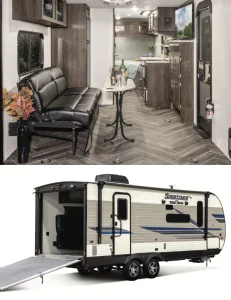Using RVs for basecamp.
Sustainable Living Practices that Reduce the Ecological Footprint
More than 1.7 million Canadian families use recreational vehicles (RVs) for travel and leisure time, including hunting and fishing. The variety and types of “toy-hauler” RVs span the range from tent campers right up to 40-plus foot fifth-wheel trailers. Here’s a look at some interesting options.
Garage space in RVs
Toy-hauler RVs include living quarters as well as a garage. Typically, the rear wall of the trailer folds down and doubles as a ramp to drive toys in and out of the box (or transport boats, kayaks, and canoes).
This is a common design available in a wide variety of lengths. Many offer convertible beds, couches, and tables that make use of the garage for on-site living space. These features can add as many as four sleeping spaces to what’s available in the front of the trailer. Fold-down ramps often double as patios, some with screened rooms. This all adds extra living space while on site. Then, when the trip is over, stow everything away, load the machines, and tow it all home.

Forest River Cherokee Wolf Pack 325Pack13
This 40-foot fifth wheel is self-sustaining, carrying 100 gallons of fresh water, an Onan generator and its own on-board gas station. Its dropdown solid rear ramp opens a 12-foot garage space. The ramp itself (at 13-feet) can be used as a patio — when suspended in a level position. The garage space also has its own man-door to what becomes a living/sleeping space when unloaded.
A removable dinette table and convertible sofa give way to a powered drop-down bed at night. The garage also has its own two-piece bathroom. The separate living space easily sleeps six (with the overhead loft as an extra sleeping space) while offering a private front bedroom with full bath.
The living area has a full kitchen. The main dinette is a surrounded by a U-shaped convertible couch.
Mid-size toy haulers
KZ’s Sportsmen THLE series starts at 24’, 3” and weighs 4,520 pounds. These travel trailers feature a 73” x 88” ramp door leading into a cargo area of up to 11 feet. Rollover sofa(s) occupy the cargo safe when you’re not loaded up and a freestanding table is easily moved to wherever it’s needed. The flooring is called “ToughGuard” — an important item for hauling motorized equipment.
Also check out Jayco’s Jay Flight Octane. The smallest model, the 222, has a 7-foot ramp/patio (with a 3,000-pound capacity) leading into an 8’6” cargo area.
TAXA Mantis
This unit is part of a relatively new niche in the world of RVing, called overlanding, which takes the off-grid, out-of-the-park trend a step further. This 19-foot trailer has space for four and accommodates pets and adventure toys. Low roof access height is offset with a pop-up fabric tent-roof. The Mantis features 20 gallons of fresh water, a wet bath with cassette toilet, two-burner stove, and sink. The 12V electrical system runs most everything.
The key to an overlanding trailer is low overall weight and high ride height. The Mantis has a dry weight of just 2,972 pounds. It also features a ground clearance of 14-inches and a Timbren axle-less suspension; it also rides on Cooper Discoverer AT3, 16-inch tires. Another unique feature is a Lock ‘N’ Roll hitch. This articulating hitch has 360 degrees of rotation and three-axis movement.
The Mantis is all about using every inch of space and having design features that often serve more than one purpose. Ceiling-mounted bunks can be stowed flat when not in use.

Pop-ups
 On the lower end of the price scale, the venerable pop-up tent trailer has added an open deck to its frame. It’s enough space to transport an ATV, and can still be towed by lighter vehicles.
On the lower end of the price scale, the venerable pop-up tent trailer has added an open deck to its frame. It’s enough space to transport an ATV, and can still be towed by lighter vehicles.
Originally published in the 2021-2022 Hunting Annual issue of Ontario OUT of DOORS magazine.
Howard J Elmer is a Canadian automotive journalist who specializes in pickup trucks. He’s best known for his annual real-world testing event — the Canadian Truck King Challenge (www.truckking.ca). Contact Howard at mail@oodmag.com







